Intel Core i7 3960X (Sandy Bridge E) Review: Keeping the High End Alive
by Anand Lal Shimpi on November 14, 2011 3:01 AM EST- Posted in
- CPUs
- Intel
- Core i7
- Sandy Bridge
- Sandy Bridge E
Windows 7 Application Performance
3dsmax 9
Today's desktop processors are more than fast enough to do professional level 3D rendering at home. To look at performance under 3dsmax we ran the SPECapc 3dsmax 8 benchmark (only the CPU rendering tests) under 3dsmax 9 SP1. The results reported are the rendering composite scores.
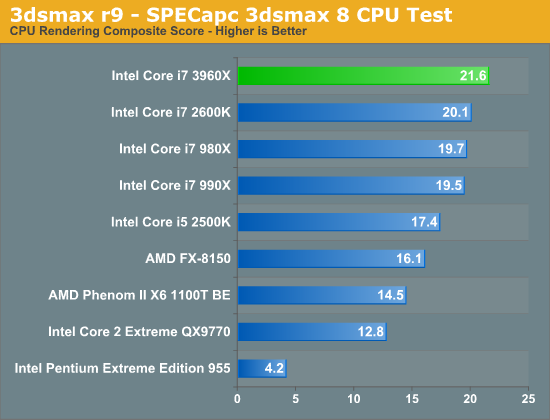
Offline 3D rendering applications make some of the best use of CPU cores, unfortunately our test here doesn't scale all that well. We only see a 7% increase over the 2600K. If we look at a more modern 3D workload however...
Cinebench 11.5
Created by the Cinema 4D folks we have Cinebench, a popular 3D rendering benchmark that gives us both single and multi-threaded 3D rendering results.
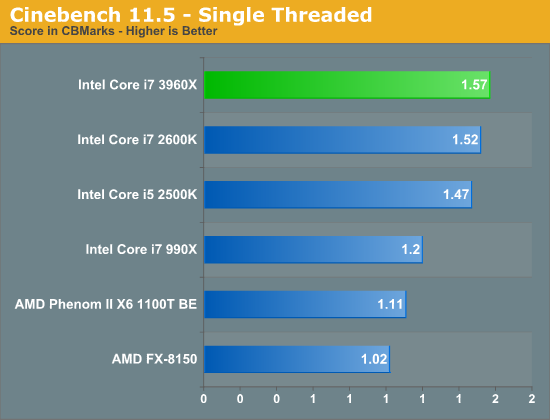
Single threaded performance is marginally better than the 2600K thanks to the 3960X's slightly higher max turbo speed. What's more important than the performance here is the fact that the 3960X is able to properly power gate all idle cores and give a single core full reign of the chip's TDP. Turbo is alive and well in SNB-E, just as it was in Sandy Bridge.
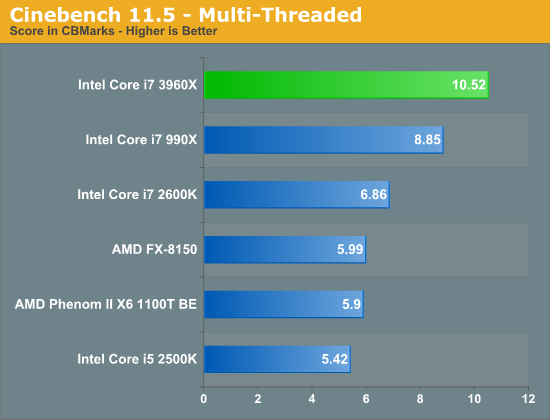
Here the performance gains are staggering. The 3960X is 53% faster than the 2600K and 19% faster than Intel's previous 6-core flagship, the 990X. The Bulldozer comparison is almost unfair, the 3960X is 75% faster (granted it is also multiple times the price of the FX-8150).
7-Zip Benchmark
While Cinebench shows us multithreaded floating point performance, the 7-zip benchmark gives us an indication of multithreaded integer performance:

Here we see huge gains over the 2600K (58%), indicating that the increase in cache size and memory bandwidth help the boost in core count a bit here. The advantage over the 990X is only 7%. This gives us a bit of a preview of what we can expect from SNB-EP Xeon server performance.
PAR2 Benchmark
Par2 is an application used for reconstructing downloaded archives. It can generate parity data from a given archive and later use it to recover the archive
Chuchusoft took the source code of par2cmdline 0.4 and parallelized it using Intel’s Threading Building Blocks 2.1. The result is a version of par2cmdline that can spawn multiple threads to repair par2 archives. For this test we took a 708MB archive, corrupted nearly 60MB of it, and used the multithreaded par2cmdline to recover it. The scores reported are the repair and recover time in seconds.
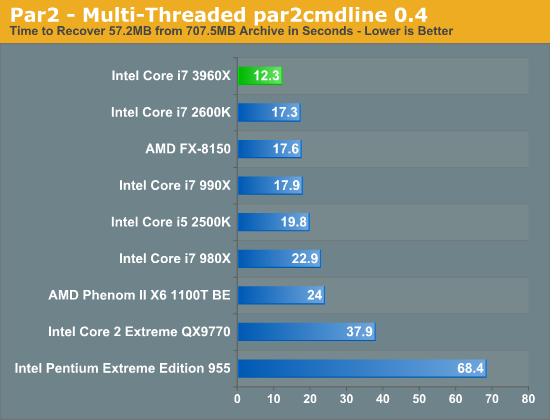
Here we see a 40% increase in performance over the 2600K and FX-8150.
TrueCrypt Benchmark
TrueCrypt is a very popular encryption package that offers full AES-NI support. The application also features a built-in encryption benchmark that we can use to measure CPU performance with:
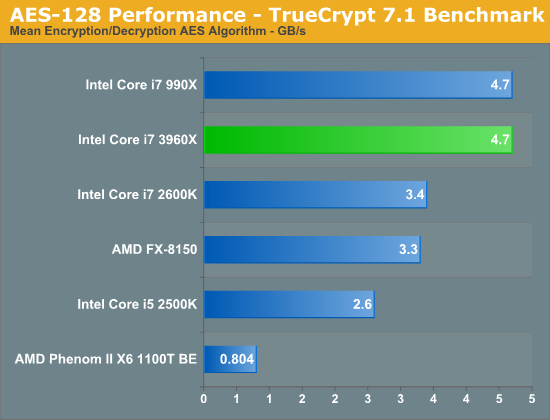
As both the 990X and 3960X have AES-NI support, both are equally capable at cranking through an AES workload. Per core performance doesn't appear to have changed all that much with the move to Sandy Bridge, so here we have a situation where the 3960X is much faster than the 2600K but no faster than the 990X. I suspect these types of scenarios will be fairly rare.
x264 HD 3.03 Benchmark
Graysky's x264 HD test uses x264 to encode a 4Mbps 720p MPEG-2 source. The focus here is on quality rather than speed, thus the benchmark uses a 2-pass encode and reports the average frame rate in each pass.
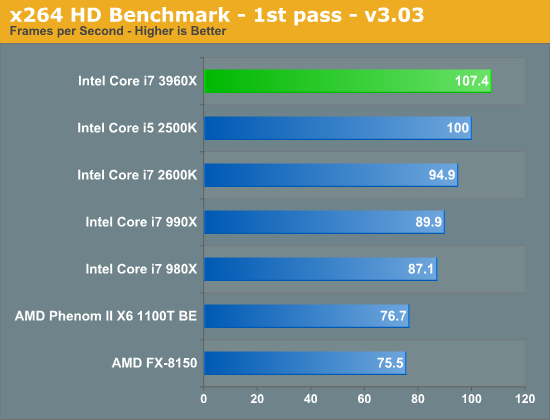
Single threaded performance isn't significantly faster than your run-of-the-mill Sandy Bridge, which means the first x264 HD pass doesn't look all that impressive on SNB-E.
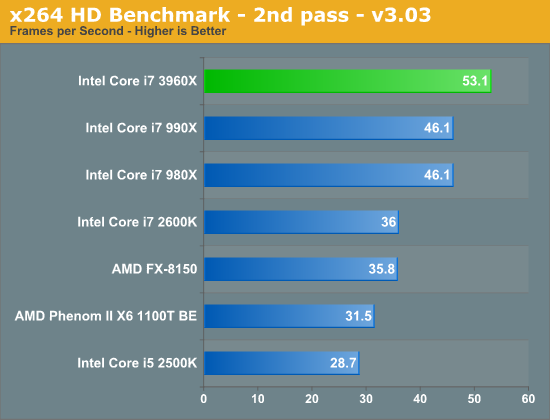
The second pass however stresses all six cores far more readily, resulting in a 47.5% increase in performance over the 2600K. Even compared to the 990X there's a 15% increase in performance.
Adobe Photoshop CS4
To measure performance under Photoshop CS4 we turn to the Retouch Artists’ Speed Test. The test does basic photo editing; there are a couple of color space conversions, many layer creations, color curve adjustment, image and canvas size adjustment, unsharp mask, and finally a gaussian blur performed on the entire image.
The whole process is timed and thanks to the use of Intel's X25-M SSD as our test bed hard drive, performance is far more predictable than back when we used to test on mechanical disks.
Time is reported in seconds and the lower numbers mean better performance. The test is multithreaded and can hit all four cores in a quad-core machine.
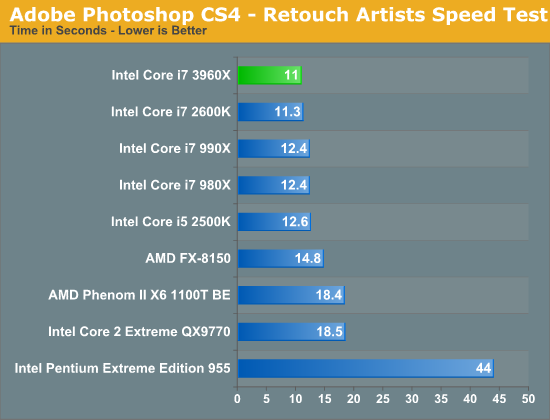
Our Photoshop test is multithreaded but there are only spikes that use more than four cores. That combined with the short duration of the benchmark shows no real advantage to the 3960X over the 2600K. Sandy Bridge E is faster than Intel's old 6-core solution though.
Compile Chromium Test
You guys asked for it and finally I have something I feel is a good software build test. Using Visual Studio 2008 I'm compiling Chromium. It's a pretty huge project that takes over forty minutes to compile from the command line on the Core i3 2100. But the results are repeatable and the compile process will stress all 12 threads at 100% for almost the entire time on a 980X so it works for me.
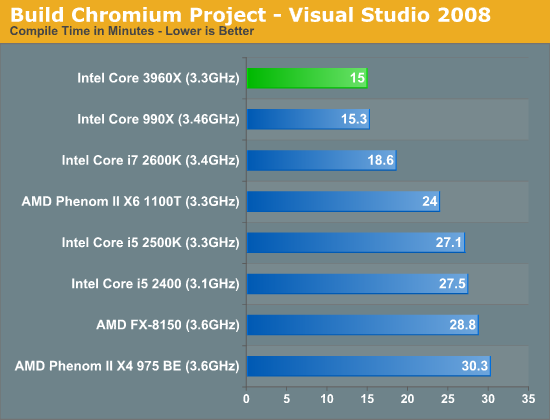
Our compile test is extremely well threaded, which once again does well on the 3960X. The gains aren't as big as what we saw in some of our earlier 3D/transcoding tests, but if you're looking to build the fastest development workstation you'll want a Sandy Bridge E.
Excel Monte Carlo
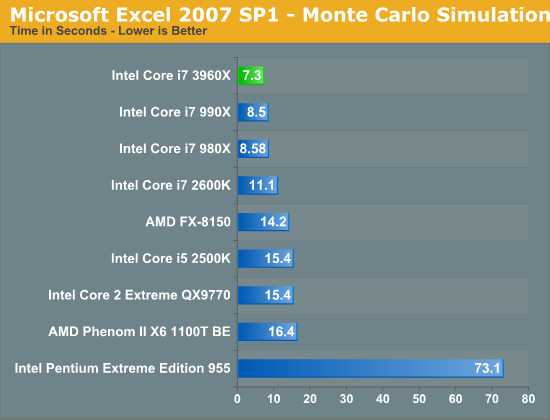
Multithreaded compute does well on SNB-E regardless of the type of application. Excel is multithreaded and if you have a beefy enough workload, you'll see huge gains over the 2600K.










163 Comments
View All Comments
mino - Monday, November 14, 2011 - link
"Quick Sync leverages the GPU's shader array"This is simply not true. And you know it. Shame.
Steelski - Tuesday, November 15, 2011 - link
irrelevant CS4 test because someone buying this kind of hardware would appreciate the CS5 advantage other websites show.jewie27 - Tuesday, November 15, 2011 - link
I was waiting for X79 but after I read the initial reviews I bought a Z68 motherboard and 2500K cpu for gaming.C300fans - Tuesday, November 15, 2011 - link
Me too. 999$+X79 for 0% improvement in gaming. What a crab! Bulludozer seems not that crab comparing to 3960x overall.yankeeDDL - Tuesday, November 15, 2011 - link
Making unsubstantiated claims about something that is non-intuitive falls, in my dictionary, under fanboy-ism (if that's a word).The fact that Win7 "runs better" on a certain, relatively old, PC, is one thing. Stating that Windows7 is faster than XP (in spite of a documented benchmark proving otherwise) is another one.
Like I said, you can compare OS in terms of HW support, ease of use, even responsiveness, however, neither of those translate into one OS beinf "faster".
Faster means that when you run a benchmark (pick any of the ones that Anand run in this article), you get a noticeable increase in speed.
The OSes provide the infrastructure to run applications, they cannot provide any fundamental speed difference, unless, of course, you have a PC without enough RAM, for example, and in that case the OS that uses less RAM will have an obvious advantage (because it offers more "free" RAM for apps to run), but that again, has nothing to do with one OS being faster: if anything, it is more efficient.
I have 4GB on both my laptop (Win7) and on my desktop (WinXP) and the difference is negligible: I nearly always have more than 2GB of RAM committed, so it is no surprise that on your PC Win7 with ReadyBoost is faster: just spend ~$15 on 2GB of RAM and you'll see a huge performance improvement both on XP and 7.
jmelgaard - Tuesday, November 15, 2011 - link
So "Faster" must not apply to the OS's capability to respond to the user, it must only apply to the OS's capability to server application requests?...Wait what?...
Kob - Tuesday, November 15, 2011 - link
You guys need to look at the engineering of your requests: 6 sata3 ports require feeding 6*6gb/s = 36 Gb/s data, while the total max theoretical mem bw of the chipset is 37 Gb/s. Can't do that while also taking care of OS, apps and video memory requirements.cbutters - Monday, December 12, 2011 - link
6*6gb/s isn't going to be happening constantly.....you build out one bridge that has a certain amount of bandwidth, 12GB perhaps, I don't know, and let the ports use the available shared bandwidth, doesn't mean you can't add additional ports, this is one of the benefits of serial interfaces.C300fans - Tuesday, November 15, 2011 - link
Intel Gulftown 6C 32nm 6 1.17B 240mm2Intel Sandy Bridge E (6C) 32nm 6 2.27B 435mm2
SB-E, What a crab! Double Transistors, Double size, merely 20% gain from SB 2600k. 999$ for this? I would rather get 2 pcs Interlagos 6200 instead.
sna1970 - Tuesday, November 15, 2011 - link
using 5870 CF to show us that dual 8x PCIE are same as dula 16x is a mistake I am shocked some one like you fall in ...you should have tested 6990 in CF , or 590 ... and see the difference between 16x SLI/CF and 8x SLI/CF
and how do you consider a 5870 a MODERN GPU ?
Quote : "Modern GPUs don't lose much performance in games, even at high quality settings, when going from a x16 to a x8 slot."
Answer : WRONG . try high end dual GPU cards in SLI/CF !